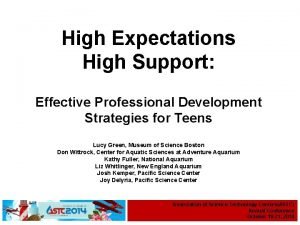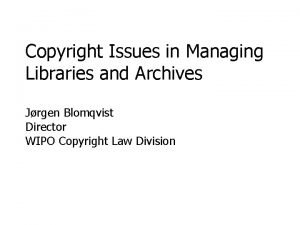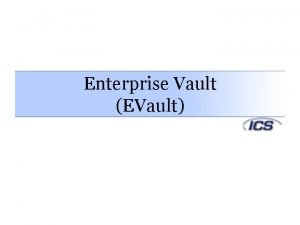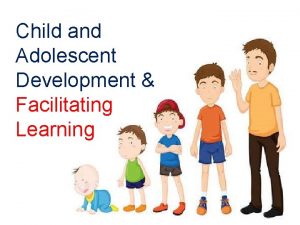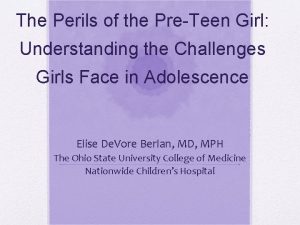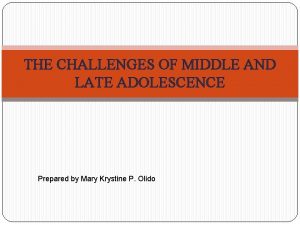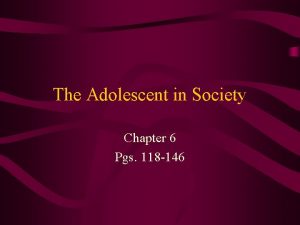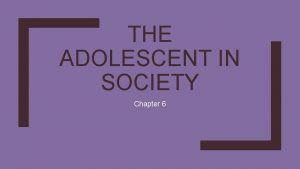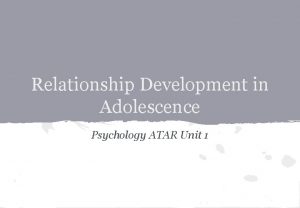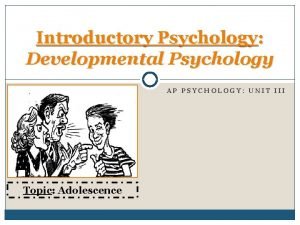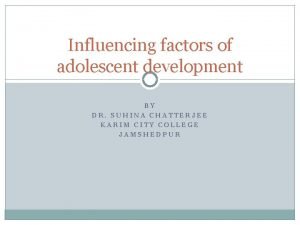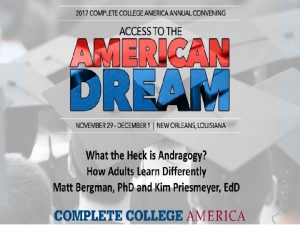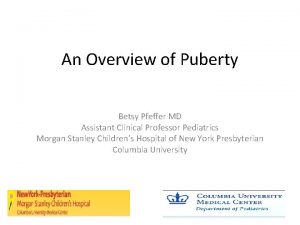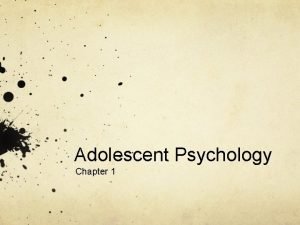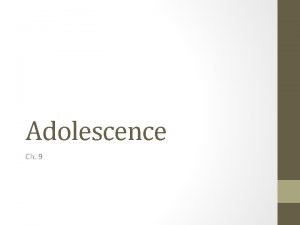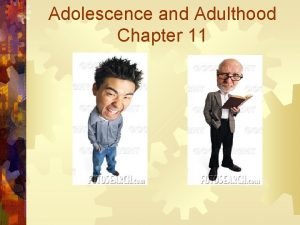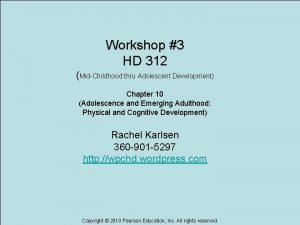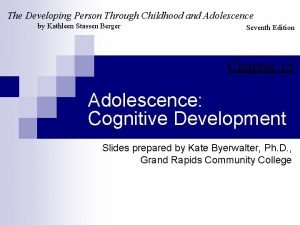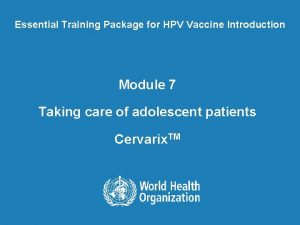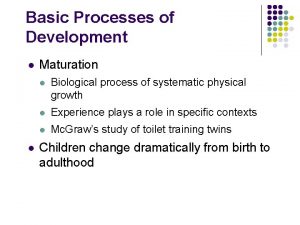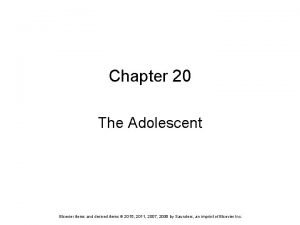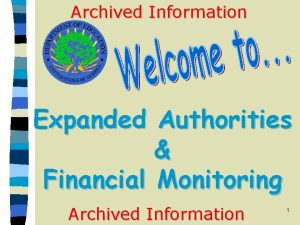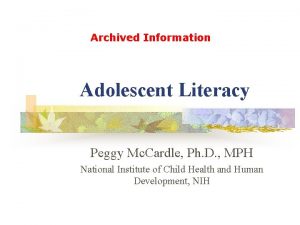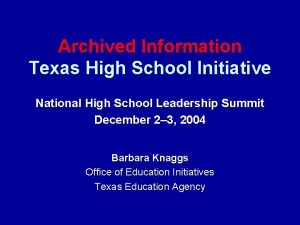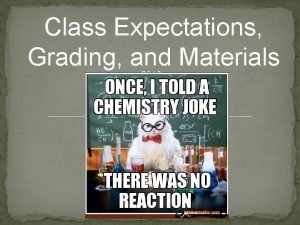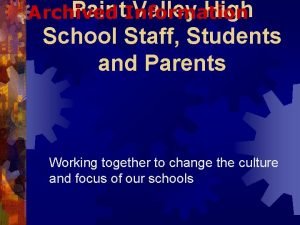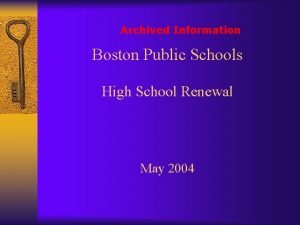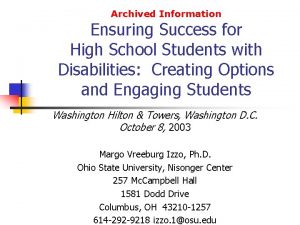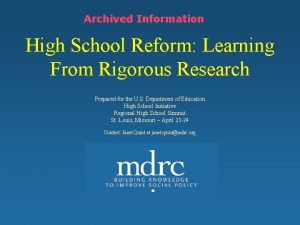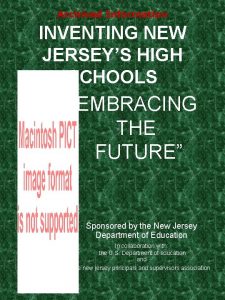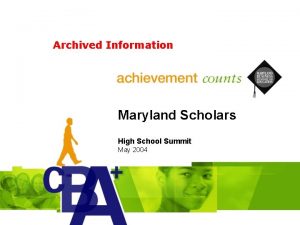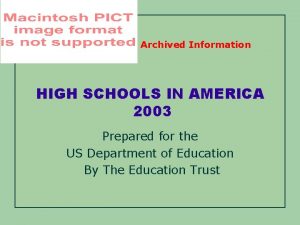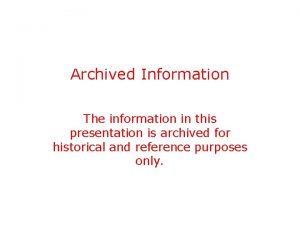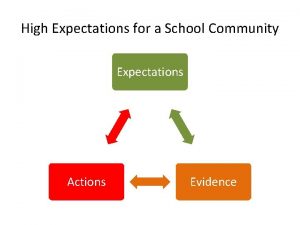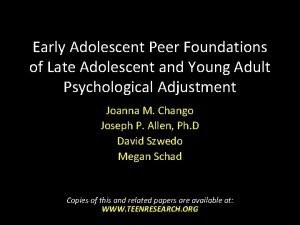Archived Information High Expectations and Adolescent Reading The































- Slides: 31

Archived Information High Expectations and Adolescent Reading The University of Kansas Center for Research on Learning Don Deshler Mike Hock October 8, 2003

About the KU-CRL Founded in 1978 Mission: Dramatically improve the performance of at-risk students in grades 4 -12 through research-based interventions • $70+ million dollars of contracted R & D • International Professional Development Network • 275, 000 teachers in 3, 500 school districts CRL

Our Purpose Today…. . “What is the role of high expectations and AYP in reading, particularly for those who struggle with learning? ”

The Performance Gap 12 NCLB 2013 -2014 School Year 11 Years in School 10 9 8 The “GAP” 7 6 5 2001 -2002 School Year 4 3 2 Student Skills 1 1 2 3 4 5 6 7 8 9 10 11 12

Students in the Gap…. . • Who are they? – Low SES – Students w/disabilities – English Language Learners • What do they need? – Systematic & Direct Instruction in skills & strategies – Intensive intervention (time & engagement) – Practice & Feedback (lots!) – Academic motivation – High expectations

Vaughn, Gersten, & Chard (2000) • Interventions that benefit SLD also benefit average and high achievers • Instruction that is visible & explicit • Instruction that is interactive between students & teacher & between students • Instruction that controls task difficulty • Strategies that guide student learning

Direct Instruction • • • Small steps Probes Feedback Diagrams/pictures Independent practice Strategy Instruction • Clear Explanations • Teacher models • Reminders to use strategies • Step-by-step prompts Swanson (1999)

CRL Response to Literacy Instruction is about Closing the Performance Gap by attending to Content Enhancement only happens through by promoting Strategy Instruction High Expectations & Administrative Leadership

. The Content Literacy Continuum Level 1: Ensure mastery of critical content. Level 2: Weave shared strategies across classes. Level 3: Support mastery of shared strategies for targeted courses/demands. - Small group strategy instruction - Extended day program (tutoring) Level 4: Develop intensive skill course options for those who need basic skills. Level 5: Develop more intensive clinical options for those who need foundational language competencies.

CRL Adolescent Literacy Continuum 2. General Education Embedded Strategies 1. General Education Enhanced Content Students not making AYP in reading 4. Evidence-Based Reading Class 3. Intensive Reading Strategy Support • strategy classes • strategic tutoring 5. Clinical Intervention

Content Enhancement Routines (Levels 1 and 2) • A way of teaching academically diverse classes in which ØThe integrity of the content is maintained ØCritical content is selected and transformed ØContent is taught in an active partnership with students ØStrategies are embedded in the course and introduced to students

Content Enhancement Teaching Routines Planning and Leading Learning Course Organizer Unit Organizer Lesson Organizer Explaining Text, Topics, and Details Framing Routine Survey Routine Clarifying Routine Teaching Concepts Concept Mastery Routine Concept Anchoring Routine Concept Comparison Routine Increasing Performance Quality Assignment Routine Question Exploration Routine Recall Enhancement Routine Vocabulary Routine

Concept Diagram 3 Key Words elephant CONCEPT DIAGRAM 1 Mammal 1 CONVEY CONCEPT 2 OFFER OVERALL CONCEPT 3 NOTE KEY WORDS 4 CLASSIFY CHARACTERISTICS: Always Present warm-blooded human nurse their young has hair warm-blooded Vertebrate Sometimes Present + + walks on 2 legs walks on 4 legs + swims in water Never Present O cold-blooded can fly moves on the ground nurse their young 5 EXPLORE EXAMPLES Examples: Nonexamples: whale human snake elephant alligator bird shark whale walks on 4 legs bat can fly cold-blooded 6 PRACTICE WITH NEW EXAMPLE 7 TIE DOWN A DEFINITION duckbill platypus shark bird A mammal is a warm-blooded vertebrate that has hair and nurses its young. 2

Concept Mastery Results Test scores of students with disabilities on unit tests

Self-Questioning Strategy (embedded in 7 th grade science class) • Attend to clues as you read • Say some questions • Keep predictions in mind • Identify the answer • Talk about the answers

Self-Questioning-2001 n= 133 7 th Grade Science Class: Growth Scores

Learning Strategies (Level 3: Moving students off of the yellow line) • Teaching students how to think about and solve problems, or……teaching students “how to learn” • For example: How can I use my textbook to learn critical science content? How do I actually read the textbook?

What Reading Skills & Strategies Should We Teach? A Framework for Adolescent Reading* Alphabetics Fluency Vocabulary Comprehension • PA • Decoding • Pace • Listening • Self-Regulation • Accuracy • Reading Strategies - self-questioning - visual imagery - paraphrasing - expository text - interpreting visuals • Word ID • Prosody * Based upon information from The National Reading Panel, 2000; Adolescent Reading: A Synthesis of Research, Mary Curtis, 2002; Rand Reading Study Group: Reading for Understanding, Catherine Snow, 2002.

Learning Strategies Curriculum Acquisition Storage Word Identification First-Letter Mnemonic Paraphrasing Paired Associates Self-Questioning Listening/Notetaking Visual Imagery LINCS Vocabulary Interpreting Visuals Multipass The Bridging Strategy (decoding, word id, fluency) Draw Inferences Expression of Competence Sentences Paragraphs Error Monitoring Themes Assignment Completion Test-Taking

Word Identification • • • Discover the context Isolate the prefix Separate the suffix Say the stem Examine the stem • Check with someone • Try the dictionary


State Writing Assessment Percentage of Students Passing the Michigan State Writing Assessment 100 90 80 70 60 50 40 30 20 10 0 94 85 74. 5 Strategies School Mean of Other Same-Sized School State Average

Strategic Tutoring Model A before or after school tutoring program in which tutors teach students critical skills and strategies while they help students with homework assignments. The Role of the Strategic Tutor: �Explain Content, Build Knowledge �Have Extensive Knowledge of Strategies �Apply Principles of Strategic Instruction �Mentor and “Connect” Students

Data Analysis (1) • Scores earned by tutored students in general education classes on Quizzes and Tests • N= 40 Chase, Landon, Eisenhower, Robinson – – Pretest Scores 1: 1 tutoring 59% 1: 3 tutoring 52% Hm. Wk help 65% Comparison 63% Posttest Scores 73% 60% 67% 54%

Data Analysis (2) • Student Level of Hope 1: 1 Strategic Tutoring • Total Score Pre= 20 pts – Will Power – Way Power . 0432 10 pts 11 pts Post= 28 pts 15 pts 13 pts Pre= 23 pts 11 pts 12 pts Post= 23 pts 12 pts 11 pts 1: 3 Tutoring – Total Score – Will Power – Way Power

Strategic Tutoring Outcomes : Assignments are completed successfully : New content knowledge is acquired : Effective Strategies are learned & applied Ø Scores are quizzes and tests improve Ø Performance on state measures improves : Students are “connected” with a mentor & hope increases

Student Motivation & Possible Selves Students are not unmotivated. However they may not be motivated to do what we want them to do. Rick Lavoie Students are motivated when they: -Have a goal THEY desire -BELIEVE the goal is attainable -Have a realistic PLAN on how to get there

Possible Selves (Markus & Nurris, 1986) • Possible Selves are ideas about what one might become in the future • When stories about one’s hopes, expectations, and fears for the future are expressed, they can be motivating. • Individuals with clear ideas about the future will work hard to attain them.

“What is the role of high expectations and AYP in reading, particularly for those who struggle with learning? ”

on i s Vi Be + + Validated practices lie Fidelity implementation Student Success = Coordinated implementation Quality Professional Development Strong Administrative Leadership fs

www. ku-crl. org University of Kansas Center for Research on Learning Ddeshler@ku, edu mhock@ku. edu 1 -785 -864 -4780 (CRL)
 High expectations high support
High expectations high support Moe archived dmca
Moe archived dmca How to enable enterprise vault in outlook
How to enable enterprise vault in outlook Difference between dating and courting
Difference between dating and courting While reading activities
While reading activities Set high expectations which inspire motivate and challenge
Set high expectations which inspire motivate and challenge Facilitating learning child and adolescent development
Facilitating learning child and adolescent development Discontinuous development psychology
Discontinuous development psychology Pre adolescent girl
Pre adolescent girl 3 filipino adolescent heroes
3 filipino adolescent heroes Chapter 6 the adolescent in society
Chapter 6 the adolescent in society Chapter 6 the adolescent in society
Chapter 6 the adolescent in society Dexter dunphy 5 stages
Dexter dunphy 5 stages Adolescent age range psychology
Adolescent age range psychology Factors that influence adolescent development?
Factors that influence adolescent development? Erikson stages of development
Erikson stages of development Generativity vs stagnation
Generativity vs stagnation Elkind's theory of adolescent egocentrism
Elkind's theory of adolescent egocentrism Adolescence stage
Adolescence stage Adolescent turmoil definition
Adolescent turmoil definition It is a science and art of helping adults to learn.
It is a science and art of helping adults to learn. Early adolescent age
Early adolescent age Adolescent generalization gap
Adolescent generalization gap Developmental tasks for adolescent
Developmental tasks for adolescent Adolescent generalization gap
Adolescent generalization gap Adolescent egocentrism
Adolescent egocentrism Adolescent egocentrism
Adolescent egocentrism Adolescent definition
Adolescent definition 1994
1994 Adolescent family violence program
Adolescent family violence program Adolescent meaning
Adolescent meaning Chapter 20 the adolescent
Chapter 20 the adolescent
